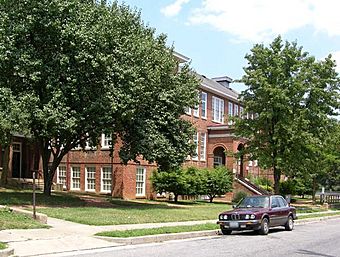Harrison School (Roanoke, Virginia) facts for kids
|
Harrison School
|
|

Harrison School, June 2010
|
|
| Location | 523 Harrison Ave., NW, Roanoke, Virginia |
|---|---|
| Area | 0.8 acres (0.32 ha) |
| Built | 1916 |
| Architect | Page, J.H. |
| NRHP reference No. | 82004592 |
Quick facts for kids Significant dates |
|
| Added to NRHP | September 9, 1982 |
The Harrison School is an old public school building in Roanoke, Virginia. It was built for African-American students. The building is made of brick and has a special style called Georgian Revival. It opened in 1916, and more parts were added in 1922.
This school was important because it was the first in Roanoke to teach Black students past the seventh grade. Its first principal was a famous educator named Lucy Addison. After closing as a school in the 1960s, the building was used for a daycare center. Later, it became homes for people with lower incomes. It also housed the Harrison Museum of African American Culture. The school was added to the National Register of Historic Places in 1982.
Contents
The History of Harrison School
At the start of the 1900s, education for African-Americans was not a main focus in many Southern states. Roanoke had schools for young Black children since the 1870s. However, students who wanted to study past the seventh grade had to travel far. They went to Virginia State University in Petersburg.
Lucy Addison was a teacher in Roanoke's Gainsboro area since 1886. She strongly believed in getting a new school for older students. The city school board agreed in 1916. The Harrison School opened the next year, with Lucy Addison as its first principal.
Building the School
The new school building cost almost $32,000 to build in 1916. This amount would be worth much more today. It was designed in a modified Georgian style. This style was very popular for school buildings at that time. The building has three stories and is made of brick. It has thirteen sections, or "bays," along its front.
In 1922, the school needed more room. Two new wings were added. These wings had two stories and three sections each.
Early Years and Growth
In its first year, Harrison School had only 14 students. It only taught eighth grade. But each year, another semester of high school classes was added. By 1924, the first group of students graduated after four full years at Harrison. The school officially earned its state approval in 1925. Also in 1925, Lucy Addison helped get a free dental clinic added to the school.
Lucy Addison stopped working in education in 1927. By then, Harrison School had 1,300 students. This was the largest number of students in any school in the city. In 1928, the city built a new high school for its Black students. They named it after Lucy Addison. A newspaper at the time said it was the first public building in Roanoke named after one of its citizens.
After the new high school was built, Harrison School continued to be used. It served as an elementary and middle school. A report from 1941 by Virginia's Department of Education found problems with the school. It said the building needed many repairs and more money for upkeep. The school also did not have a gym, an auditorium, or proper restrooms for male teachers.
Closing and New Uses
Harrison School was used as an elementary school until the 1960s. It closed in 1971 when schools in Roanoke City became integrated. After closing, the building was used as a daycare center until 1979. Then, it was empty for a few years.
In 1982, the school was listed on the National Register of Historic Places. That same year, the US Department of Housing and Urban Development (HUD) gave money. A local group used this money to turn the building into homes for senior citizens. The renovation also made space for the new Harrison Museum of African American Culture.
At first, there were rules about how much space the museum could use. This was because of the HUD loans. But Jim Olin, Roanoke's representative in Congress, worked to change this. He succeeded in getting an exception for the museum. Within a year, the Harrison Museum used the entire bottom floor of the building.
In 2009, the Harrison Museum moved out of the old school building. It reopened in a downtown Roanoke arts and culture center in 2013. The space the museum used to have was turned into more apartments for people with lower incomes.



